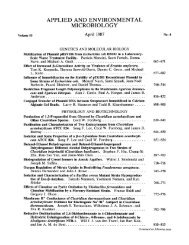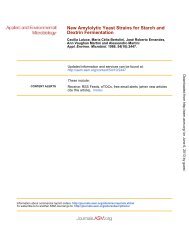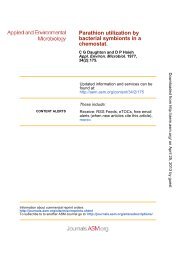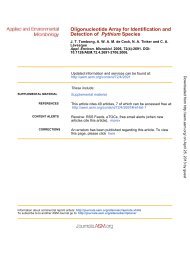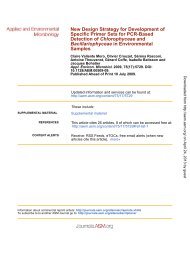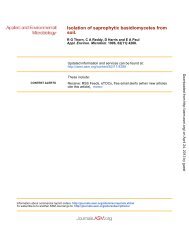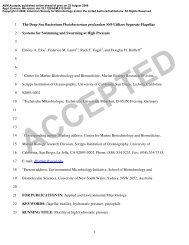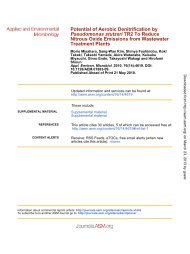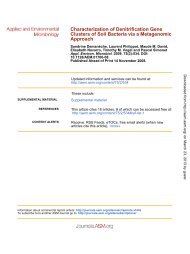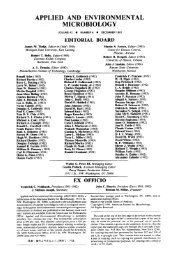Defence Research Laboratory, Post Bag No-2, Tezpur-784001 ...
Defence Research Laboratory, Post Bag No-2, Tezpur-784001 ...
Defence Research Laboratory, Post Bag No-2, Tezpur-784001 ...
Create successful ePaper yourself
Turn your PDF publications into a flip-book with our unique Google optimized e-Paper software.
AEM Accepts, published online ahead of print on 15 October 2010<br />
Appl. Environ. Microbiol. doi:10.1128/AEM.01441-10<br />
Copyright © 2010, American Society for Microbiology and/or the Listed Authors/Institutions. All Rights Reserved.<br />
Title : Construction of ScFv Antibody against Staphylococcal<br />
3. Present Address: <strong>Defence</strong> <strong>Research</strong> <strong>Laboratory</strong>, <strong>Post</strong> <strong>Bag</strong> <strong>No</strong>-2, <strong>Tezpur</strong>-<strong>784001</strong>, Assam,<br />
INDIA<br />
Superantigen SEB<br />
Running title : ScFv antibody for specific detection of SEB<br />
Authors : Pawan Kumar Singh 1 , Ranu Agrawal 1 , Dev Vrat Kamboj 1* ,<br />
Garima Gupta 2 , M. Boopathi 2 , Ajay Kumar Goel 1 ,<br />
1, 3<br />
Lokendra Singh<br />
Address of the Institution : <strong>Defence</strong> <strong>Research</strong> and Development Establishment, Jhansi<br />
Road, Gwalior- 474002, Madhya Pradesh, INDIA<br />
Affiliation of Authors : 1. Biotechnology Division, <strong>Defence</strong> <strong>Research</strong> and<br />
Development Establishment, Jhansi Road, Gwalior-<br />
474002, Madhya Pradesh, INDIA<br />
2. Protective Devices Division, <strong>Defence</strong> <strong>Research</strong> and<br />
Development Establishment, Jhansi Road, Gwalior-<br />
474002, Madhya Pradesh, INDIA<br />
* Corresponding Author : Dr Dev Vrat Kamboj, Biotechnology Division, <strong>Defence</strong><br />
<strong>Research</strong> and Development Establishment, Jhansi Road,<br />
Gwalior- 474002, INDIA.<br />
Phone: 91-751-2347545. Fax: 91-751-2341148.<br />
E-mail: kamboj_dev@yahoo.com
1<br />
2<br />
3<br />
4<br />
5<br />
6<br />
7<br />
8<br />
9<br />
10<br />
11<br />
12<br />
13<br />
14<br />
15<br />
16<br />
17<br />
18<br />
19<br />
Abstract<br />
Staphylococcal food poisoning (SFP) is the most prevalent causes of foodborne illness<br />
throughout the world. SFP is caused by twenty one different types of staphylococcal<br />
enterotoxins produced by S. aureus. Among these, staphylococcal enterotoxin B (SEB) is the<br />
most potent toxin and is a listed biological warfare (BW) agent. Therefore, development of<br />
immunological reagents for detection of SEB is of utmost importance. High affinity and specific<br />
monoclonal antibodies are being used for detection of SEB but hybridoma clones tend to lose the<br />
antibody secreting ability over the period of time. This problem can be overcome by the use of<br />
recombinant antibodies produced in bacterial system. In the present investigation, genes from a<br />
hybridoma clone encoding monoclonal antibody against SEB were immortalized using antibody<br />
phage display technology. A murine phage display library containing single chain variable<br />
fragment (ScFv) antibody genes was constructed in a pCANTAB5E phagemid vector. Phage<br />
particles displaying ScFv were rescued by reinfection of helper phage followed by four rounds of<br />
biopanning for selection of SEB binding ScFv antibody fragments using phage ELISA. Soluble<br />
SEB-ScFv antibodies were characterized from one of the clones showing high affinity for SEB.<br />
The SEB-ScFv antibody was highly specific and its affinity constant was 3.16 nM as determined<br />
by Surface Plasmon Resonance (SPR). These results demonstrate that the recombinant antibody<br />
constructed by immortalizing the antibody genes from hybridoma clone is useful for<br />
immunodetection of SEB.<br />
2
1<br />
2<br />
3<br />
4<br />
5<br />
6<br />
7<br />
8<br />
9<br />
10<br />
11<br />
12<br />
13<br />
14<br />
15<br />
16<br />
17<br />
18<br />
19<br />
20<br />
21<br />
22<br />
23<br />
24<br />
Introduction<br />
Staphylococcus aureus is one of the most prevalent causative agents of foodborne illness<br />
throughout the world. The illness occurs following ingestion of staphylococcal enterotoxins<br />
(SEs) produced by S. aureus in the contaminated food. The symptoms of food poisoning include<br />
nausea, vomiting, abdominal cramps and diarrhea. Twenty one different types of SEs, i.e.,<br />
staphylococcal enterotoxin A (SEA) – staphylococcal enterotoxin E (SEE) and staphylococcal<br />
enterotoxin G (SEG) – staphylococcal enterotoxin V (SEV) have already been discovered (33,<br />
40). The immunomodulatory effects of SEs, such as immunosupression, enhancement of<br />
endotoxic shock and induction of cytokine release can be attributed to the fact that SEs are potent<br />
T-cell mitogens. The ability of SEs to induce proliferation of T-cells is somewhat similar to<br />
conventional antigen presentation by MHC class II molecules to T-cell receptors (TCRs).<br />
However, unlike conventional antigens, the T-cell mitogenicity of SEs does not require antigen<br />
processing and lacks the normal specificity to the TCR for specific epitopes in response to<br />
conventional antigens. This bypass of normal TCR specificity for conventional T-cell epitopes<br />
results in the stimulation of a substantial proportion of the total T-cell population and, therefore,<br />
staphylococcal enterotoxins are referred as superantigens. The stimulation of T-cells leads to<br />
overproduction of cytokines causing clinical symptoms that include fever, hypotension and even<br />
death in severe cases (3, 30, 39).<br />
Among SEs, SEB is the most potent toxin secreted by S. aureus (3, 35). This is a single<br />
polypeptide containing 239 amino acids with a molecular weight of 28 kDa. SEB is highly<br />
resistant to proteases, boiling temperature and extremes of pH because of its compact tertiary<br />
structure (5, 27). In humans, 3.5 µg of SEB ingested by oral route causes emesis (5). SEB is<br />
extremely toxic by inhalation and as low as 30 ng is sufficient to cause fever, respiratory<br />
complaints (cough, dyspnea and retrosternal discomforts or chest pain) and gastrointestinal<br />
3
1<br />
2<br />
3<br />
4<br />
5<br />
6<br />
7<br />
8<br />
9<br />
10<br />
11<br />
12<br />
13<br />
14<br />
15<br />
16<br />
17<br />
18<br />
19<br />
20<br />
21<br />
22<br />
23<br />
24<br />
symptoms. Severe intoxication results in pulmonary edema, adult respiratory distress syndrome<br />
(ARDS), shock and death (28, 37, 42). Although exposure of SEB through inhalation route is not<br />
characteristic feature of S. aureus infection, but this characteristic makes SEB a candidate of<br />
biological terrorism and, hence, it is a listed biological warfare agent (21, 26). Therefore, its<br />
quick and unambiguous detection is of paramount importance.<br />
Avaibality of specific and high affinity antibodies is the major bottleneck in the development of<br />
immunodetection system for SEB. Any immunological detection system for SEB requires<br />
specific and high affinity antibodies but SEB being a superantigen leads to the generation of low<br />
titred polyclonal antibodies. The problem is further aggravated if SEB is contaminated even<br />
slightly with other undesired proteins leading to non-specific antiserum. Polyclonal antibodies<br />
are generated using SEB purified by conventional protein purification methods which do not<br />
result in sufficiently pure SEB for generation of specific and sensitive antibodies (6, 22).<br />
Alternatively, hybridoma technology has also been used to generate monoclonal antibodies<br />
against SEB but hybridoma clones tend to lose their antibody secreting ability over the period of<br />
time (11, 23). In recent times, the advent of recombinant DNA and gene amplification<br />
technology have made it possible to clone desired antibody genes in bacteria using antibody<br />
phage display technology. Such immortalization of antibody genes has made it technically<br />
feasible to produce monoclonal antibody called single chain variable fragment (ScFv) quickly in<br />
bacterial culture. Theses ScFv antibody molecules can further be genetically manipulated for<br />
improved specificity and affinity (8). The cost of their production is very low and these can be<br />
fused with marker molecule for immunological detection of several bacterial and viral agents<br />
(43). However, construction of such ScFv molecules for detection of SEB has not been reported<br />
so far. Therefore, the objective of the present study was to construct recombinant antibody<br />
(ScFv) against SEB for use in immunological detection.<br />
4
1<br />
2<br />
3<br />
4<br />
5<br />
6<br />
7<br />
8<br />
9<br />
10<br />
11<br />
12<br />
13<br />
14<br />
15<br />
16<br />
17<br />
18<br />
19<br />
20<br />
21<br />
22<br />
Materials and methods<br />
Materials. All chemicals and organic solvents were reagent grade or better. Plasmid<br />
pCANTAB5E, Escherichia coli strains TG1 and HB2151, M13K07 helper phage, mouse anti-<br />
M13 HRP conjugated antibody, mouse anti-E tag HRP conjugated antibody and restriction<br />
enzymes SfiI and <strong>No</strong>tI were procured from GE healthcare UK Limited (Buckinghamshire, UK).<br />
Cell culture media, reagents and fetal bovine serum were purchased from Sigma-Aldrich Inc. (St.<br />
Louis, MO, USA), unless and otherwise specified. Goat anti-mouse HRP conjugated antibody<br />
was purchased from Dako Denmark A/S (Rødovre, Denmark). PCR amplification primers listed<br />
in table 1 were synthesized by Microsynth AG (Balgach, Switzerland). Test antigen, i.e.,<br />
recombinant SEB (r-SEB, MW ~30.5 kDa) was prepared earlier in the laboratory. All DNA<br />
manipulations, if not described, were carried out by standard procedures (38)<br />
Generation of hybridoma. Eight weeks old female Balb/c mice, were immunized<br />
subcutaneously with SEB at three weeks interval. The priming dose consisted of 150 µg r-SEB<br />
per mouse in Freund’s complete adjuvant. The booster consisted of 75 µg antigen in Freund’s<br />
incomplete adjuvant. Mice were test bled and the anti-serum was checked by ELISA to<br />
determine the response. Mice were given a booster of 150 µg antigen three days prior to fusion.<br />
Spleen cells were collected and fused with mouse myloma cells as described by Harlow and<br />
Lane (13). Culture supernatant from the clones was tested in ELISA against 1 µg antigen.<br />
Positive clones were expanded and repeatedly tested for antibody secretion by ELISA.<br />
Monoclonal antibody culture supernatants were also used for determining the isotype by ELISA.<br />
The hybridoma clone 2F6D9G2 was selected and maintained in Dulbecco’s Modified Eagle<br />
Medium supplemented with gentamycin (50 µg/ml) and 10% (vol/vol) FBS for RNA isolation.<br />
5
1<br />
2<br />
3<br />
4<br />
5<br />
6<br />
7<br />
8<br />
9<br />
10<br />
11<br />
12<br />
13<br />
14<br />
15<br />
16<br />
17<br />
18<br />
19<br />
20<br />
21<br />
22<br />
23<br />
24<br />
Amplification of antibody variable region genes. Total RNA was extracted from hybridoma<br />
cells using TRI reagent (Sigma-Aldrich Inc., St. Louis, MO, USA) as per manufacturer’s<br />
instructions. cDNA was synthesized by reverse transcription (Ominiscript RT kit, QIAGEN<br />
GmbH, Hilden, Germany) using variable heavy (VH) and variable light (VL) chain reverse<br />
primers (Table 1) against the conserved 3’-end of antibody variable region genes. RS VH For mix<br />
& Lin VH Rev mix and Lin VL For mix & RS VL Rev mix degenerate primers were used for the<br />
amplification of VH and VL chains, respectively (Table 1). PCR protocol consisting of initial<br />
denaturation at 94ºC for 5 min followed by 35 cycles of denaturation (94ºC/1 min), annealing<br />
(50ºC/1 min), extension (72ºC/2 min), and final extension at 72ºC for 10 min. PCR products<br />
were resolved by agarose gel electrophoresis and eluted using QIAquick gel extraction kit.<br />
Construction of SEB-ScFv expression vector. PCR amplified VH and VL gene fragments<br />
containing linker overhangs were joined together by overlap extension PCR using equimolar<br />
concentrations of VH and VL gene fragments. RS VH For mix and RS VL Rev mix were used for<br />
the ScFv construction. The optimum PCR conditions have been described earlier except<br />
annealing (63ºC/1 min). The assembled ScFv gene was resolved on 1.5% agarose gel and the<br />
DNA band was eluted using QIAquick gel extraction kit. ScFv gene was digested with SfiI and<br />
<strong>No</strong>tI restriction enzymes and ligated into SfiI and <strong>No</strong>tI linearized phagemid vector,<br />
pCANTAB5E. Electrocompetent E. coli TG1 cells were transformed with the resulting<br />
phagemid vector, pCANTAB5E-ScFv, by electroporation. Transformed TG1 cells were<br />
recovered in 1 ml of 2X YT medium containing 2% (vol/vol) glucose and incubated at 37 o C for<br />
1 h. Transformed cells were then plated on SOB agar plates containing 20 g/L glucose and 100<br />
µg/ml ampicillin followed by overnight incubation at 30 o C. Colonies obtained on these plates<br />
were scraped and recovered with 2X YT medium. A portion of this culture mixture was diluted<br />
to an OD600 of ~0.5 in 2X YT-AG (2X YT medium containing 100 µg/ml ampicillin and 2%<br />
6
1<br />
2<br />
3<br />
4<br />
5<br />
6<br />
7<br />
8<br />
9<br />
10<br />
11<br />
12<br />
13<br />
14<br />
15<br />
16<br />
17<br />
18<br />
19<br />
20<br />
21<br />
22<br />
23<br />
24<br />
[vol/vol] glucose) for biopanning. Glycerol stocks were prepared from rest of the scraped cells<br />
and stored at -80 o C.<br />
Rescue of phagemid library and biopanning of phage antibody library. Phage particles<br />
displaying ScFv were rescued by infection with helper phage (M13K07). Briefly the above<br />
diluted culture was grown and helper phage was added with 20 moi (multiplicity of infection).<br />
After incubation of 30 min without shaking and for another 30 min with shaking, culture was<br />
centrifuged at 1,000 X g for 10 min. The entire cell pellet was gently resuspended in 10 ml of 2X<br />
YT-AK medium (2X YT medium containing 100 µg/ml ampicillin and 50 µg/ml kanamycin).<br />
After overnight incubation at 37 o C with shaking at 250 rpm, the culture was again centrifuged at<br />
1,000 X g for 20 min at room temperature and the supernatant containing recombinant phage<br />
particles was collected. The phage particles were precipitated by PEG/NaCl on ice for 1 h and<br />
collected by centrifugation at 10,000 X g for 20 min at 4 o C. Precipitated phage particles were<br />
resuspended in 2X YT medium and their titre was determined for subsequent biopanning<br />
experiments.<br />
The ScFv phage library was biopanned for binders against SEB in a 25 cm 2 culture flask. For<br />
biopanning, the phage rescuing was done as described above. The resuspended phage particles<br />
were diluted with 10 ml of 10% MPBS (PBS containing 10% [wt/vol] skim milk and 0.01%<br />
sodium azide) and incubated at room temperature for 15 min. Diluted recombinant phage<br />
particles (20 ml) were added to the SEB coated flask followed by blocking with 10% MPBS for<br />
2 h at 37 o C. The flask was washed 10 times with PBST (PBS containing 0.05% [vol/vol] Tween<br />
20) and another 10 times with PBS. Log phase TG1 cells (10 ml) were added to the flask and<br />
incubated for 1 h with shaking at 37 o C for reinfection with phage particles. The enriched library<br />
was then plated on SOB plates containing ampicillin (100 µg/ml) and glucose (2%), rescued, and<br />
used for further panning cycles. Further cycles were carried out essentially as described above,<br />
7
1<br />
2<br />
3<br />
4<br />
5<br />
6<br />
7<br />
8<br />
9<br />
10<br />
11<br />
12<br />
13<br />
14<br />
15<br />
16<br />
17<br />
18<br />
19<br />
20<br />
21<br />
22<br />
23<br />
24<br />
with increasing stringency and number of wash cycles. After four rounds of biopanning, 20<br />
clones were randomly selected for further analysis.<br />
Screening for SEB specific binders by phage ELISA. SEB binding clones were selected by<br />
phage ELISA. Rescue of individual phage colonies was carried out as described above. Maxisorp<br />
ELISA plate was coated with SEB in bicarbonate buffer (pH 9.6). After blocking with 4%<br />
MPBS, approximately 10 12 phage particles were added and incubated for 1 h at room<br />
temperature. Bound phage particles were detected after incubation with 1:2,000 dilution of anti-<br />
M13 HRP conjugated antibody. The colorimetric reaction was performed with ABTS [2, 2’-<br />
azino-bis (3-ethyl-benzothiazoline-6-sulfonic acid)] as the enzyme substrate. BSA coated wells<br />
were used as negative control. Clones were considered positive if they demonstrated at least<br />
twice the signal developed in the negative control.<br />
Expression of soluble SEB-ScFv antibodies and screening by western blot. To produce<br />
soluble anti-SEB ScFv, a strong positive recombinant phage clone was made to infect log-phase<br />
E. coli HB2151 cells. Expression of soluble SEB-ScFv was induced by Isopropyl-β-D-<br />
thiogalactopyranoside (IPTG; final concentration, 1 mM). The culture was induced for 7 h at<br />
30 o C followed by centrifugation at 1,500 X g for 20 min. Cell pellet was resuspended in ice-cold<br />
1X-TES at the rate of 2% of initial culture volume. Subsequently, ice cold 1/5 X-TES was added<br />
at the rate of 3% of initial culture volume and the mixture was incubated on ice for 30 min to<br />
induce a mild osmotic shock. The contents were centrifuged at 12,000 X g for 10 min. The<br />
supernatant, containing the soluble antibodies from the periplasm was transferred to fresh tubes<br />
and stored at -20 o C. Periplasmic extract containing SEB-ScFv antibody was resolved on a 12%<br />
SDS-PAGE and stained with coomassie brilliant blue R-250. Proteins resolved on SDS-PAGE<br />
were blotted on PVDF membrane. After blocking the membrane with 5% MPBS, the SEB-ScFv<br />
was detected by incubating the blot with anti E-tag HRP conjugated antibodies. The blot was<br />
8
1<br />
2<br />
3<br />
4<br />
5<br />
6<br />
7<br />
8<br />
9<br />
10<br />
11<br />
12<br />
13<br />
14<br />
15<br />
16<br />
17<br />
18<br />
19<br />
20<br />
21<br />
22<br />
23<br />
developed using DAB/H2O2 solution. Purification of ScFv antibodies from the periplasmic<br />
extract of E. coli was carried out using anti-E-tag affinity column (GE Healthcare UK Limited,<br />
Buckinghamshire, UK) according to the manufacturer’s instructions.<br />
Antigen binding assay for SEB-ScFv antibodies. The SEB binding assay for the SEB-ScFv<br />
antibodies was done both by ELISA and western blotting. For direct measurement of antigen<br />
binding activity, ELISA plate wells were coated with 250 ng SEB in bicarbonate buffer (pH 9.6).<br />
After blocking with 5% MPBS, different dilutions of SEB-ScFv antibodies were incubated for 1<br />
h at room temperature. Untransformed HB2151 periplasmic extract was used as negative control.<br />
Bound SEB-ScFv was detected with anti E-tag HRP conjugated antibodies.<br />
Binding of SEB-ScFv with SEB was also confirmed by western blotting. For this, 1 µg SEB was<br />
run on 12% SDS-PAGE and blotted on PVDF membrane. After blocking with 5% MPBS the<br />
blot was incubated with SEB-ScFv antibodies. The blot was then incubated with anti E-tag HRP<br />
conjugated antibody and developed using DAB/H2O2 solution.<br />
Nucleic acid analysis of SEB-ScFv antibody gene. The SEB-ScFv antibody gene cloned in<br />
pCANTAB5E phagemid vector was sequenced using vector specific primers, pCANTAB5-S1<br />
(5’-CAACGTGAAAAAATTATTATTCGC-3’) and pCANTAB5-S6 (5’-<br />
GTAAATGAATTTTCTGTATGAGG-3’). Sequences were delineated and analyzed using<br />
LaserGene version 5.07/5.52 software (DNASTAR Inc., Madison, WI, USA) and were<br />
submitted to the NCBI GenBank. Both the heavy and light chain variable region sequences were<br />
numbered as per Kabat rule (20). Canonical classes of each of the CDR regions were identified<br />
as per Chothia and Lesk (7) using online software (http://www.bioinf.org.uk/abs/). The SEB-<br />
ScFv sequence was also analyzed online using the V-Quest software provided by the<br />
International ImMunoGeneTics information system (IMGT) (http://imgt.cines.fr) for<br />
9
1<br />
2<br />
3<br />
4<br />
5<br />
6<br />
7<br />
8<br />
9<br />
10<br />
11<br />
12<br />
13<br />
14<br />
15<br />
16<br />
17<br />
18<br />
19<br />
20<br />
21<br />
22<br />
identification of germline origin of VH/VL regions (12). Homology searches for nucleotide and<br />
protein sequences were done using BLAST (1).<br />
Affinity determination of SEB-ScFv by Surface Plasmon Resonance (SPR). The<br />
biomolecular interaction and affinity of SEB-ScFv was measured using a two channel cuvette<br />
based electrochemical surface plasmon resonance (SPR) system (Autolab ESPRIT, EcoChemie,<br />
The Netherlands). The SPR measurement was automatically monitored by data acquisition<br />
software version 4.3.1 supplied along with the instrument. All the SPR measurements were<br />
carried out at 25 o C. SEB antigen was immobilized on a carboxymethyldextran modified gold<br />
disc as per manufacturer’s instructions. A flow rate of 16.5 µl/s was maintained during the SPR<br />
interaction measurements, and a set of five SEB-ScFv dilutions (10 nM to 1 µM) prepared in<br />
PBS were performed for 700 s. After each SEB-ScFv dilution, the chip was regenerated with 10<br />
mM HCl for 120 s. Affinity constant was calculated using Kinetic Evaluation Software Version<br />
5.0 supplied with the SPR.<br />
Specificity profile of SEB-ScFv. Specificity of SEB-ScFv antibody was determined by ELISA<br />
against staphylococcal enterotoxins (SEA, SEC1, C2, C3, and SED) that are frequently<br />
associated with SFP outbreaks. SEB-ScFv bound to antigen was detected by incubation with<br />
anti-E tag HRP conjugated antibody. The colorimetric reaction was performed with ABTS as the<br />
enzyme substrate.<br />
Results<br />
Generation of mouse monoclonal antibody. The hybridoma was generated by using a stringent<br />
screening method as described earlier. After immunization the titer of mouse antiserum was<br />
1:51200 as observed by ELISA. Ten ELISA positive clones were obtained after fusion. After<br />
10
1<br />
2<br />
3<br />
4<br />
5<br />
6<br />
7<br />
8<br />
9<br />
10<br />
11<br />
12<br />
13<br />
14<br />
15<br />
16<br />
17<br />
18<br />
19<br />
20<br />
21<br />
22<br />
23<br />
repeated subcloning one clone, 2F6D9G2, showing IgG1 isotype was expanded further for ScFv<br />
construction.<br />
PCR amplification of variable region genes and cloning of ScFv gene. VH and VL chain genes<br />
were amplified by PCR from 2F6D9G2 hybridoma clone. VH gene product formed a band at<br />
~340 bp and VL at ~325 bp as revealed on agarose gel (Fig 1A). The VH and VL fragments<br />
containing linker overhangs were joined to generate single chain variable fragment at ~750 bp<br />
(Fig 1B).<br />
ScFv library construction and biopanning. A phage antibody library of the order of 6.5 X 10 11<br />
PFU/ml size was obtained by cloning the ScFv genes in pCANTAB5E phagemid vector. After<br />
four rounds of biopanning, 20 clones were randomly selected for binding with SEB antigen. One<br />
of the clones, 4PCL2, showing maximum reactivity against SEB was selected for further studies.<br />
Expression of soluble SEB-ScFv antibody. The SEB-ScFv antibody was expressed in soluble<br />
form in 4PCL2 infected HB2151 cells after induction with IPTG. A protein band at ~29 kDa,<br />
corresponding to the expected size of SEB-ScFv, was detected in the periplasmic extract of<br />
4PCL2 infected HB2151 cells (Fig 2A). The presence of SEB-ScFv band at ~29 kDa by western<br />
blot using anti-E-tag HRP conjugated antibody further confirmed its expression (Fig 2B).<br />
SEB binding activity and affinity determination of SEB-ScFv antibody. The SEB binding<br />
activity of different dilutions of SEB-ScFv was studied by ELISA. It was observed that with<br />
increase or decrease in the concentration of SEB-ScFv there was an increase or decrease in<br />
binding with SEB as revealed by OD values (Fig 3A). The effective binding of SEB-ScFv with<br />
SEB antigen was further confirmed by western blot and the outcome is depicted as Fig 3B.<br />
Further, affinity of SEB-ScFv to the SEB antigen was studied by SPR using the SEB<br />
immobilized sensor chip. It was observed that increase in concentration of antibody increases the<br />
11
1<br />
2<br />
3<br />
4<br />
5<br />
6<br />
7<br />
8<br />
9<br />
10<br />
11<br />
12<br />
13<br />
14<br />
15<br />
16<br />
17<br />
18<br />
19<br />
20<br />
21<br />
22<br />
23<br />
SPR response linearly. The SPR data were used for the quantitative determination of the affinity<br />
constant of the SEB-ScFv antibody. The calculated affinity constant of SEB-ScFv was in low<br />
nanomolar range (3.16 nM) as determined by Kinetic evaluation software version 5.0.<br />
Sequence analysis of variable region genes. The nucleotide sequence of 4PCL2 ScFv was<br />
submitted to GenBank (NCBI accession no GQ465983). The nucleotide and amino acid<br />
sequence of the variable heavy chain (Table 2) and variable light chain (Table 3) regions of<br />
4PCL2 ScFv aligned with mouse germline genes. Analysis of the amino acid sequences revealed<br />
that CDR L1, CDR L2, CDR L3 and CDR H1 belong to type 1 canonical class. CDR H2 belongs<br />
to class 2, and 7 residues long CDR H3 has a kinked profile. Homology search using V-Quest<br />
software revealed that the heavy chain variable region of 4PCL2 is 94.10% identical with mouse<br />
germ line VH gene, IGHV1-58*01 (IMGT accession no AC0871666). The light chain variable<br />
region belongs to Vκ 4 class and is 95.65% identical to mouse germline genes, IGKV4-61*01<br />
(IMGT accession no AJ231209) and IGKV4-68*01 (IMGT Accession no. AJ231222). Figure 4<br />
shows an IMGT “collier de perle” (pearl necklace) graphical 2-D representation of 4PCL2 ScFv.<br />
Differences between 4PCL2 ScFv and amino acid coded by the mouse germinal genes most<br />
similar to 4PCL2 ScFv are indicated in the figure.<br />
Discussion<br />
SFP caused by SEs is one of the most prevalent causes of gastroenteritis worldwide (4, 32).<br />
Among different types of SEs, SEB is the most potent and is also a listed biological warfare<br />
agent (21, 26). Therefore, development of immunodiagnostic reagents against SEB is of utmost<br />
importance. Any immunological detection system for SEB requires specific and sensitive<br />
antibodies but SEB being a superantigen leads to the production of low titred antiserum in<br />
animal models. Contamination of SEB with other proteins results in non-specific antiserum<br />
12
1<br />
2<br />
3<br />
4<br />
5<br />
6<br />
7<br />
8<br />
9<br />
10<br />
11<br />
12<br />
13<br />
14<br />
15<br />
16<br />
17<br />
18<br />
19<br />
20<br />
21<br />
22<br />
23<br />
24<br />
generation as conventional purification methods do not yield homogenously pure SEB (6, 22).<br />
The problem of non-specific and low titred antibodies was addressed with the generation of<br />
monoclonal antibody using hybridoma technology. But hybridoma clones secreting monoclonal<br />
antibody are genetically unstable and tend to lose the antibody secreting ability in due course of<br />
time, however, reasons for the same are not very well understood (11, 23). These problems were<br />
overcome with the advent of new molecular biology tool called “Antibody Phage Display<br />
Technology”. The antibody phage display technology is one of the most remarkable<br />
achievements in antibody engineering. With this technique, the repertoire of VH and VL genes are<br />
amplified and joined together by PCR and finally inserted into a phagemid (17). After<br />
transformation into E. coli, phage displaying the desired antibody fragment, called ScFv, on its<br />
surface is enriched and selected by a technique called biopanning. In this way, the antibody<br />
phage display technique links the phenotype of ScFv to its genotype which can be cloned into an<br />
E. coli host secreting soluble ScFv antibodies (19, 25). Therefore, the antibody phage display<br />
technology permits the immortalization of monoclonal antibody encoding genes from hybridoma<br />
clone. This technique also facilitates the gene manipulation to improve the affinity of the<br />
antibody.<br />
In the present study, we report the construction of a highly reactive and specific ScFv antibody<br />
fragment from a phage display library suitable for SEB detection. Gene encoding monoclonal<br />
antibody reactive against SEB was immortalized by cloning in E. coli using antibody phage<br />
display technology and the resultant recombinant antibody was characterized. The VH and VL<br />
chain genes were amplified separately along with 15 amino acid long (Gly4Ser)3 linker molecule.<br />
Both these genes were joined by a single step method called overlap extension PCR which<br />
minimizes the possibility of mutations associated with multiple steps PCR (15). Usually 15<br />
residue hydrophilic sequence (Gly4-Ser)3 is used for the linker, but short linker molecules from 5-<br />
13
1<br />
2<br />
3<br />
4<br />
5<br />
6<br />
7<br />
8<br />
9<br />
10<br />
11<br />
12<br />
13<br />
14<br />
15<br />
16<br />
17<br />
18<br />
19<br />
20<br />
21<br />
22<br />
23<br />
24<br />
25<br />
10 amino acids result in the multimerization of ScFv molecule leading to enhanced avidity (24,<br />
41). The ScFv gene was cloned into pCANTAB5E vector and a large repertoire of antibody<br />
library (6.5 X 10 11 PFU/ml) was obtained. The size of the library is dependent and governed by<br />
the transformation efficiency which is the major limitation of antibody phage display technology<br />
(2). Screening of phage antibody library revealed the expression of SEB-ScFv on phage surface.<br />
The pIII protein fused upstream of the SEB-ScFv facilitates its transportation onto the phage<br />
surface. This helps in selection of ScFv molecules reactive against the desired antigen, i.e., SEB.<br />
After four rounds of biopanning, the clone, 4PCL2, showing maximum binding with SEB was<br />
selected for further studies. The recombinant phage (4PCL2) displaying SEB-ScFv antibody was<br />
made to infect a non-supressor E. coli strain HB2151. In this E. coli strain, translation is aborted<br />
after the synthesis of the ScFv due to recognition of a stop codon. This results in the production<br />
and secretion of soluble ScFv antibodies in to the periplasmic location of the bacteria (16). In<br />
this study, soluble SEB-ScFv (~29 kDa) was successfully expressed in the periplasmic extract of<br />
E. coli. The nucleic acid sequence analysis of the antibody heavy and light chains indicates that it<br />
belongs to the canonical class of 1-2-1-1-1 (i.e., H1-H2-L1-L2-L3). Homology search using<br />
IMGT/V-Quest revealed variation in VH and VL genes of SEB-ScFv from the mouse germline<br />
genes. This variation is attributed to 14 replacements and three silent mutations in VH gene, and<br />
nine replacements and three silent mutations in VL gene of SEB-ScFv. The ratio of replacement<br />
to silent mutations in the CDRs was 4/0 and 2/2 in VH and VL genes, respectively. If replacement<br />
mutation takes place randomly, expected number of replacement mutations at CDRs would be<br />
5.6 in VH and 3 in VL genes (18). The affinity of SEB-ScFv antibody is very high (3.16 nM)<br />
which shows that SEB antigen and its corresponding SEB-ScFv antibody interact with high<br />
affinity. Mechaly and coworkers (31) reported ScFv antibodies against Bacillus anthracis spores<br />
with affinity in low nanomolar range (30 nM). On the other hand, even picomolar level of KD (41<br />
pM) has also been reported for ricin toxin (36). Further, SEB-ScFv antibody did not cross-react<br />
14
1<br />
2<br />
3<br />
4<br />
5<br />
6<br />
7<br />
8<br />
9<br />
10<br />
11<br />
12<br />
13<br />
14<br />
15<br />
16<br />
17<br />
18<br />
19<br />
20<br />
21<br />
with SEs (SEA, SEC1, SEC2, SEC3 and SED) commonly implicated in SFP outbreaks making it<br />
useful for SEB detection.<br />
Reports for the construction of recombinant antibodies for the detection of foodborne pathogens<br />
(29, 34), toxins (9, 10) and biological warfare agents (9, 10, 14, 31, 36) are scanty. Recombinant<br />
Fab antibodies, isolated from a phage display library, have been used in detection of botulinum<br />
toxin (9, 10). Phage display was also utilized for the construction of ScFv antibodies against<br />
biological warfare agents like Anthrax (31) Brucella melitensis (14) and Ricin (36). This study<br />
on construction of first ScFv antibody against SEB will facilitate specific detection of SEB in<br />
cases of SFP and in the event of biological terrorism.<br />
Acknowledgements<br />
Authors are thankful to Director, DRDE Gwalior for providing the research facilities. Authors<br />
are also thankful to Prof. Dr. Stefan Dübel and Dr. Michael Hust, Department of Biotechnology,<br />
Technical University of Braunschweig, Germany for guiding to troubleshoot the problems faced<br />
during the course of study.<br />
References<br />
1. Altschul, S. F., W. Gish, W. Miller, E. W. Mayers, and D. J. Lipman. 1990. Basic local<br />
alignment search tool. J. Mol. Biol. 215:403-410.<br />
2. Azzazy, H. M. E., and W. E. Highsmith, Jr. 2002. Phage display technology: Clinical<br />
applications and recent innovations. Clin. Biochem. 35:425-445.<br />
3. Baker, M. D., A. C. Papageorgiou, R. W. Titball, J. Miller, S. White, B. Lingard, J. J.<br />
Lee, D. Cavanagh, M. A. Kehoe, J. H. Robinson, and K. R. Acharya, 2002. Structural and<br />
15
1<br />
2<br />
3<br />
4<br />
5<br />
6<br />
7<br />
8<br />
9<br />
10<br />
11<br />
12<br />
13<br />
14<br />
15<br />
16<br />
17<br />
18<br />
19<br />
20<br />
21<br />
22<br />
23<br />
functional role of threonine 112 in a superantigen Staphylococcus aureus enterotoxin B. J.<br />
Biol. Chem. 277:2756-2762.<br />
4. Balaban, N., and A. Rasooly. 2000. Staphylococcal Enterotoxins. Int. J. Food Microbiol.<br />
61:1-10.<br />
5. Bergdoll, M. S. 1983. Enterotoxins, Staphylococci and Staphylococcal infections p.559-598,<br />
In C. S. F. Easmon, C. Adlam (ed.), Academic Press, New York. N.Y.<br />
6. Casman, E. P., and R. W. Bennett. 1964. Production of antiserum for staphylococcal<br />
enterotoxin. Appl. Microbiol. 12:363-367.<br />
7. Chothia, C., and A. M. Lesk. 1987. Canonical structures for the hypervariable loops of<br />
immunoglobulins. J. Mol. Biol. 196:901-917.<br />
8. Coia, G., P. J. Hudson, and R. A. Irving. 2001. Protein affinity maturation in vivo using E.<br />
coli mutator cells. J. Immunol. Methods 251:187–193.<br />
9. Emanuel, P. A., J. Dang, J. S. Gebhardt, J. Aldrich, E. A. Garber, H. Kulaga, P. Stopa,<br />
J. J. Valdes, and A. Dion-Schultz. 2000. Recombinant antibodies: a new reagent for<br />
biological agent detection. Biosens. Bioelectron. 14:751–759.<br />
10. Emanuel, P., T. O’Brien, J. Burans, B. R. DasGupta, J. J. Valdes, and M. Eldefrawi.<br />
1996. Directing antigen specificity towards botulinum neurotoxin with combinatorial phage<br />
display libraries. J. Immunol. Methods 193:189–197.<br />
11. Frame, K. K., and W. S. Hu. 1990. The loss of antibody productivity in continuous culture<br />
of hybridoma cells. Biotechnol. Bioeng. 35:469-476.<br />
12. Giudicelli, V., D. Chaume, and M. P. Lefranc. 2004. IMGT/V-QUEST, an integrated<br />
software program for immunoglobulin and T cell receptor V-J and V-D-J rearrangement<br />
analysis. Nucleic Acid Res. 32:435-440.<br />
16
1<br />
2<br />
3<br />
4<br />
5<br />
6<br />
7<br />
8<br />
9<br />
10<br />
11<br />
12<br />
13<br />
14<br />
15<br />
16<br />
17<br />
18<br />
19<br />
20<br />
21<br />
22<br />
23<br />
24<br />
25<br />
13. Harlow, E., and D. Lane. 1988. Antibodies: A laboratory manual. Cold Spring Harbor<br />
<strong>Laboratory</strong> Press, Cold Spring Harbor, NY.<br />
14. Hayhurst, A., S. Happe, R. Mabry, Z. Koch, B. L. Iverson, and G. Georgiou. 2003.<br />
Isolation and expression of recombinant antibody fragments to the biological warfare<br />
pathogen Brucella melitensis. J. Immunol. Methods 276:185–196.<br />
15. Heng, C. K., T. C. Seng, N. Khalid, J. A. Harikrishna, and R. Y. Othman. 2003.<br />
Synthesis of a soluble flag-tagged single chain variable fragment (scFv) antibody targeting<br />
cucumber mosaic virus (CMV) coat protein. Asia Pac. J. Mol. Biol. Biotehnol. 11:93-100.<br />
16. Hoogenboom, H. R., A. D. Griffiths, K. S. Johnson, D. J. Chriswell, P. Hudson, and G.<br />
Winter. 1991. Multi-subunit proteins on the surface of filamentous phage: methodologies for<br />
displaying antibody (Fab) heavy and light chains. Nucleic Acid Res. 19:4133-4137.<br />
17. Hoogenboom, H. R., A. P. de Bruin, S. E. Hufton, R. M. Hoet, J. W. Arends, and R. C.<br />
Roovers. 1998. Antibody phage display technology and its applications. Immunotechnology<br />
4:1-20.<br />
18. Ikematsu, H., Y. Ichiyoshi, E. W. Schettino, M. Nakamura, and P. Casali. 1994. VH and<br />
V kappa segment structure of anti-insulin IgG autoantibodies in patients with insulin-<br />
dependent diabetes mellitus: evidence for somatic selection. J. Immunol. 152:1430-1441.<br />
19. Jurado, P., D. Ritz, J. Beckwith, V. de Lorenzo, and L. A. Fernandez. 2002. Production<br />
of functional single-chain Fv antibodies in the cytoplasm of Escherichia coli. J. Mol. Biol.<br />
320:1-10.<br />
20. Kabat, E. A., T. T. Wu, H. M. Perry, K. S. Gottesman, and C. Foeller. 1991. Sequences<br />
of Proteins of Immunological Interest, fifth ed. US Department of Health and Human<br />
Services, NIH, Bethesda, MD.<br />
21. Kamboj, D. V., A. K. Goel, and L. Singh. 2006. Biological warfare agents. Def Sci J.<br />
56:495-506.<br />
17
1<br />
2<br />
3<br />
4<br />
5<br />
6<br />
7<br />
8<br />
9<br />
10<br />
11<br />
12<br />
13<br />
14<br />
15<br />
16<br />
17<br />
18<br />
19<br />
20<br />
21<br />
22<br />
23<br />
22. Kamboj, D. V., V. Nema, A. K. Pandey, A. K. Goel, and L. Singh. 2006. Heterologous<br />
expression of Staphylococcal enterotoxin B (seb) gene for antibody production. Electron. J.<br />
Biotechnol. 9 www.ejbiotechnology.info/content/vol9/issue5/full/3/index.html.<br />
23. Kessler, N., M. Aymard, and S. Bertrand. 1993. Stability of a murine hybridoma is<br />
dependent on the clone line and culture media. In Vitro Cell. Dev. Biol. 29A:203-207.<br />
24. Kortt, A. A., M. Lah, G. W. Oddie, C. L. Gruen, J. E. Burns, L. A. Pearce, J. L. Atwell,<br />
A. J. McCoy, G. J. Howlett, D. W. Metzger, R. G. Webster, and P. J. Hudson. 1997<br />
Single-chain Fv fragments of anti-neuraminidase antibody NC10 containing five- and ten-<br />
residue linkers from dimers and with zero-residue linker a trimer. Protein Eng. 10:423-33<br />
25. Lee, M. H., and J. W. Kwak. 2003. Expression and functional reconstitution of a<br />
recombinant antibody (Fab’) specific for human apolipoprotein B-100. J. Biotechnol.<br />
101:189-198.<br />
26. Llewelyn, M., and J. Cohen. 2002. Superantigens: microbial agents that corrupt immunity.<br />
Lancet Infect Dis. 2:156-162.<br />
27. Mantis, N. J. 2005. Vaccines against the category B toxins: Staphylococcal enterotoxin B,<br />
epsilon toxin and ricin. Adv. Drug Delivery Rev. 57:1424-1439.<br />
28. Mattix, M. E., R. E. Hunt, C. L. Wilhelmson, A. J. Johnson, and W. B. Baze. 1995.<br />
Aerosolized staphylococcal enterotoxin B-induced pulmonary lesions in rhesus monkeys<br />
(Macaca mulatta). Toxicol Pathol. 23:262–268.<br />
29. Mayer, T., J. Stratmann-Selke, J. Meens, T. Schirmann, G. F. Gerlach, R. Frank, S.<br />
Dübel, K. Strutzberg-Minder, and M. Hust. 2010. Isolation of scFv fragment specific to<br />
OmpD of Salmonella typhimurium. Vet. Microbiol., in press.<br />
doi:10.1016/j.vetmic.2010.06.023.<br />
18
1<br />
2<br />
3<br />
4<br />
5<br />
6<br />
7<br />
8<br />
9<br />
10<br />
11<br />
12<br />
13<br />
14<br />
15<br />
16<br />
17<br />
18<br />
19<br />
20<br />
21<br />
22<br />
23<br />
24<br />
25<br />
30. McCormic, J. K., J. M. Yarwood, and P. M. Schlievert. 2001. Toxic shock syndrome and<br />
bacterial superantigens: an update. Annu. Rev. Microbiol. 55:77-104.<br />
31. Mechaly, A., E. Zahavy, and M. Fisher. 2008. Development and Implementation of a<br />
Single-Chain Fv Antibody for Specific Detection of Bacillus anthracis Spores. Appl.<br />
Environ. Microbiol. 74:818–822.<br />
32. Nema, V., R. Agrawal, D. V. Kamboj, A. K. Goel, and L. Singh, 2007. Isolation and<br />
characterization of heat resistant enterotoxigenic Staphylococcus aureus from a food<br />
poisoning outbreak in Indian subcontinent. Int. J. Food Microbiol. 117:29-35.<br />
33. Ono, H. K., K. Omoe, K. Imanishi, Y. Iwakabe, D. L. Hu, H. Kato, N. Saito, A. Nakane,<br />
T. Uchiyama, and K. Shinagawa. 2008. Identification and characterization of two novel<br />
staphylococcal enterotoxins, Types S and T. Infect. Immun. 76:4999-5005.<br />
34. Paoli, G. C., L. G. Kleina, and J. D. Brewster. 2007. Development of Listeria<br />
monocytogenes-specific immunomagnetic beads using a single-chain antibody fragment.<br />
Foodborne Pathog. Dis. 4:74-83.<br />
35. Papageorgiou, A. C., H. S. Tranter, and K. R. Acharya. 1998. Crystal structure of<br />
microbial superantigen staphylococcal enterotoxin B at 1.5 Å resolution: implications for<br />
superantigen recognition by MHC class II molecules and T-cell receptors. J. Mol. Biol.<br />
277:61-79.<br />
36. Pelat T., M. Hust, M. Hale, M. P. Lefranc, S. Dübel, and P. Thullier. 2009. Isolation of a<br />
human-like antibody fragment (scFv) that neutralizes ricin biological activity. BMC<br />
Biotechnol. 9:60 http://www.biomedcentral.com/1472-6750/9/60<br />
37. Rusnak, J. M., M. Kortepeter, R. Ulrich, M. Poli, and E. Boudreau. 2004. <strong>Laboratory</strong><br />
exposure to Staphylococcal enterotoxin B. Emerging Infect. Dis. 10:1544-1549.<br />
38. Sambrook, J., and D. W. Russel. 2001. Molecular cloning: a laboratory manual, 3rd ed.<br />
Cold Spring Harbor <strong>Laboratory</strong>, Cold Spring Harbor, N.Y.<br />
19
1<br />
2<br />
3<br />
4<br />
5<br />
6<br />
7<br />
8<br />
9<br />
10<br />
11<br />
12<br />
13<br />
14<br />
15<br />
16<br />
17<br />
39. Schlievert, P. M. 1993. Role of superantigens in human disease. J. Infect. Dis. 167:997-<br />
1002.<br />
40. Thomas, D. Y., S. Jarraud, B. Lemercier, G. Cozon, K. Echasserieau, J. Etienne, M. L.<br />
Gougeon, G. Lina, and F. Vandenesch. 2006. Staphylococcal enterotoxins like toxins U2<br />
and V, two new staphylococcal superantigens arising from recombination within the<br />
enterotoxins gene cluster. Infect. Immun. 74:4724-4734.<br />
41. Turner, D. J., M. A. Ritter, and A. J. George. 1997. Importance of the linker in expression<br />
of single-chain Fv antibody fragments: optimization of peptide sequence using phage display<br />
technology. J. Immunol. Methods 205:43-54.<br />
42. Ulrich, R. B., S. Sheldon, T. J. Taylor, C. L. Wilhelmsen, and D. R. Franz. 1997. In:<br />
Textbook of military medicine, warfare, weaponry, and the casualty. Medical aspects of<br />
chemical and biological warfare. Falls Church (VA): Office of the Surgeon General, Dept. of<br />
the Army.<br />
43. Wang, S. H., J. B. Zhang, Z. P. Zhang, Y. F. Zhou, R. F. Yang, J. Chen, Y. C. Guo, F.<br />
You, and X. E. Zhang. 2006. Construction of single chain variable fragment (scFv) and<br />
biscFv-alkaline phosphatase fusion protein for detection of Bacillus anthracis. Anal. Chem.<br />
78:997–1004.<br />
20
1<br />
2<br />
3<br />
4<br />
5<br />
6<br />
7<br />
8<br />
9<br />
10<br />
11<br />
12<br />
13<br />
14<br />
15<br />
16<br />
17<br />
18<br />
19<br />
20<br />
21<br />
22<br />
23<br />
24<br />
25<br />
Figure Legends<br />
FIG. 1. Agarose gels showing VH, VL and ScFv gene amplicons. (A) Lane 1: 100 bp DNA<br />
ladder (Fermentas); Lane 2: VH gene amplicon (~340 bp); Lane 3: VL gene amplicon (~325 bp)<br />
(B) Lane 1: 100 bp DNA ladder (Fermentas); Lane 2: ScFv gene amplicon (~750 bp).<br />
FIG. 2. SDS PAGE (A) and western blot (B) profile showing expression of SEB-ScFv in soluble<br />
form. Panel (A) Lane 1: Molecular weight markers (66, 45, 29, 20, 14.2kDa); Lane 2: Uninduced<br />
culture of 4PCL2 infected HB2151; Lane 3 & 4: Induced culture and periplasmic extract of<br />
4PCL2 infected HB2151, respectively showing SEB-ScFv band at ~29 kDa. Panel (B) Lane 1:<br />
Molecular weight markers (103, 77, 50, 34.3, 28.8, 20.7 kDa); Lane 2: Uninduced culture of<br />
4PCL2 infected HB2151; Lane 3 & 4: Induced Culture and periplasmic extract of 4PCL2<br />
infected HB2151, respectively showing SEB-ScFv band at 29 kDa.<br />
FIG. 3. ELISA (A) and Western blot (B) showing binding of SEB-ScFv with SEB antigen.<br />
ELISA was performed with different dilutions of soluble SEB-ScFv antibody. Periplasmic<br />
extract of untransformed HB2151 cells was used as negative control (OD 0.0945). Panel (B)<br />
Lane 1: Prestained molecular weight markers (70, 55, 35, 27, 15 kDa); Lane 2: r-SEB band at<br />
30.5 kDa showing binding with SEB-ScFv. The bound SEB-ScFv antibody was detected using<br />
anti-E-tag HRP conjugated antibody.<br />
FIG. 4. IMGT “Collier de Perle” graphical 2-dimensional representation of 4PCL2 ScFv. (A)<br />
Variable heavy chain (VH). (B) Variable light chain (VL). “Collier de Perle” representations are<br />
displayed according to IMGT unique numbering. Asterisks indicate differences between 4PCL2<br />
ScFv and the mouse germ line genes most similar to 4PCL2 ScFv. Hydrophobic amino acids<br />
(those with positive hydropathy index values, i.e., I, V, L, F, C, M) and tryptophan (W) are<br />
21
1<br />
2<br />
3<br />
4<br />
5<br />
6<br />
7<br />
shown in blue circles. All proline (P) residues are shown in yellow circles. The complementary-<br />
determining region (CDR-IMGT) sequences are delimited by amino acid shown in squares<br />
(anchor positions), which belongs to the neighboring FR (FR-IMGT). Dashed circles correspond<br />
to missing position according to IMGT unique numbering. Colors of circle outlines indicate<br />
regions: in the VH domain, red for CDR1-IMGT, orange for CDR2-IMGT, and purple for CDR3-<br />
IMGT; in the VL domain, blue for CDR1-IMGT, green for CDR2-IMGT, and turquoise for<br />
CDR3-IMGT.<br />
22
1<br />
2<br />
3<br />
4<br />
5<br />
TABLE 1. Primers used for amplification of variable heavy (VH), variable light (VL) and ScFv<br />
antibody genes.<br />
Primer Name Sequence (5’→3’)<br />
VH reverse Equimolar mixture of primers VHR 1, VHR 2, VHR 3 and VHR 4<br />
VHR 1 GAG GAA ACG GTG ACC GTG GT<br />
VHR 2 GAG GAG ACT GTG AGA GTG GT<br />
VHR 3 GCA GAG ACA GTG ACC AGA GT<br />
VHR 4 GAG GAG ACG GTG ACT GAG GT<br />
VL reverse Equimolar mixture of primers VLR 1, VLR 2, VLR 3 and VLR 4<br />
VLR 1 ACG TTT KAT TTC CAG CTT GG<br />
VLR 2 ACG TTT TAT TTC CAA CTT TG<br />
VLR 3 ACG TTT CAG CTC CAG CTT GG<br />
VLR 4 ACC TTG GAC AGT CAG TTT GG<br />
RS VH For mix Equimolar mixture of primers RS VHF 1 and RS VHF 2<br />
RS VHF 1* GCG GCC CAG CCG GCC ATG GCC GAG GTB CAG CTB CAG CAG TC<br />
RS VHF 2* GCG GCC CAG CCG GCC ATG GCC CAG GTG CAG CTG AAG SAR TC<br />
Lin VH Rev mix Equimolar mixture of primers Lin VHR 1, Lin VHR 2, Lin VHR 3 and Lin VHR 4<br />
Lin VHR 1 GGA ACC GCC GCC ACC AGA GCC ACC ACC GCC GGA CGA GGA AAC<br />
GGT GAC CGT GGT<br />
Lin VHR 2 GGA ACC GCC GCC ACC AGA GCC ACC ACC GCC GGA CGA GGA GAC<br />
TGT GAG AGT GGT<br />
Lin VHR 3 GGA ACC GCC GCC ACC AGA GCC ACC ACC GCC GGA CGC AGA GAC<br />
AGT GAC CAG AGT<br />
Lin VHR 4 GGA ACC GCC GCC ACC AGA GCC ACC ACC GCC GGA CGA GGA GAC<br />
GGT GAC TGA GGT<br />
Lin VL For mix Equimolar mixture of primers Lin VLF 1 and Lin VLF 2<br />
Lin VLF 1 TCT GGT GGC GGC GGT TCC GGT GGC GGT GGC GAY ATC CAG CTG<br />
ACT CAG CC<br />
Lin VLF 2 TCT GGT GGC GGC GGT TCC GGT GGC GGT GGC GAY ATT GTT CTC WCC<br />
CAG TC<br />
RS VL Rev mix Equimolar mixture of primers RS VLR 1 , RS VLR 2 , RS VLR 3 and RS VLR 4<br />
RS VLR 1** GAG TCA TTC TGC GGC CGC ACG TTT KAT TTC CAG CTT GG<br />
RS VLR 2** GAG TCA TTC TGC GGC CGC ACG TTT TAT TTC CAA CTT TG<br />
RS VLR 3** GAG TCA TTC TGC GGC CGC ACG TTT CAG CTC CAG CTT GG<br />
RS VLR 4** GAG TCA TTC TGC GGC CGC ACC TTG GAC AGT CAG TTT GG<br />
* Underline bold bases indicate SfiI site<br />
** Underline bold bases indicate <strong>No</strong>tI site<br />
23
1<br />
2<br />
3<br />
4<br />
5<br />
6<br />
7<br />
TABLE 2. Homology of 4PCL2 ScFv heavy chain with mouse germline genes.<br />
Nucleotide and amino acid sequence of 4PCL2 ScFv heavy chain variable region aligned with<br />
most homologous germline V region (IGHV1-58*01, IMGT accession no: AC087166). In the<br />
case of germline genes, only the differences in nucleotide and amino acids are shown. Amino<br />
acids are numbered according to Kabat numbering scheme. NCBI accession number for the<br />
sequence of 4PCL2 ScFv is GQ 465983.<br />
24
1<br />
2<br />
3<br />
4<br />
5<br />
6<br />
7<br />
TABLE 3. Homology of the 4PCL2 ScFv light chain with mouse germline genes.<br />
Nucleotide and amino acid sequence of 4PCL2 ScFv light chain variable region aligned with<br />
most homologous germline V region (IGKV4-61*01, IMGT accession no: AJ231209). In the<br />
case of germline genes, only the differences in nucleotide and amino acids are shown. Amino<br />
acids are numbered according to Kabat numbering scheme. NCBI accession number for the<br />
sequence of 4PCL2 ScFv is GQ 465983.<br />
25




